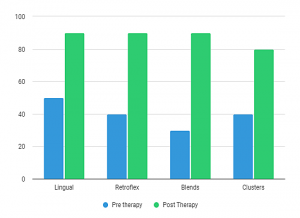
Efficacy of Online Speech Therapy after Tongue Tie Removal in an Adult: A Case study
Efficacy of Online Speech Therapy after Tongue Tie Removal in an Adult: A Case study
Tongue Tie, otherwise known as Ankyloglossia, is a condition which is present by birth. In this, the tongue of the person will be attached to the floor of the mouth. There is a thin strip of tissue called Lingual Frenulum which connects your tongue with the floor of the mouth. Tongue Tie occurs when this frenulum is short. In turn, this will affect the movements of the tongue. According to different studies, 10% of newborns are born with Tongue Tie.
There are two types of Tongue Tie. They are anterior tongue tie and posterior tongue tie. As the name suggests, anterior tongue tie is visible in the anterior portion. Whereas, posterior tongue tie is difficult to see and it’s further back of the tongue. As it’s not visible, it’s often termed as hidden tongue tie also.
Tongue tie imposes lots of difficulties depending on its severity. As far as newborn are concerned, it causes difficulty in feeding skills. It also causes restricted movements of the tongue, difficulty in articulating words which will affect the overall speech clarity. Not all tongue tie causes severe issues in feeding and speech skills.
In some cases, wherein the tongue tie causes challenges in speech and feeding skills, it’s a wiser option to correct it surgically. It’s a quick procedure involving the release of frenulum. Nowadays, laser surgery is also being done by the Dentist for the release of tongue tie.
After the release of tongue tie, a Speech Therapist can help the individual for working towards the mobility of the tongue and also works in improving the overall speech clarity by focusing on articulation of sounds involving the tongue.
The below mentioned case study is to document and to discuss the effectiveness of tele speech rehabilitation of an adult client, post tongue correction.
Method
This study involves 30 year old adult, with misarticulation, post tongue tie correction. Consent was taken from the participant for this study. The participant is a graduate and now working in a private setting. The participant had undergone tongue tie removal surgery at 2 years of age but it was not rectified. Later, laser removal of the tongue tie was done. Speech clarity was affected and the tongue movements were restricted. No intervention was done for the same in the past.
A detailed speech assessment was done which involved detailed case history, informal and formal tests. Video recording of the conversational sample and tongue movements were also taken. The Malayalam Articulation Test was administered and the participant showed errors in lingual sounds, blends and clusters. Overall speech clarity was also affected.
After the detailed assessment, the participant was recommended to undergo speech therapy.
Speech therapy was done at a frequency of once in a week for a duration of 3 months. Each session was done for 45minutes which involves therapy, home training tips and counseling.
Both assessment and speech therapy sessions were done via tele-practice using Zoom video-conferencing software. The clinician used a Lenovo Intel core i5 laptop with 30mbps speed with an in built camera and external microphone and speakers. The participant also used a Lenovo Intel core i5 laptop with an inbuilt camera and external microphone and speaker.
Treatment Strategies
Oro-motor exercises were carried out to strengthen and increase the rate and range of tongue movements. Articulation therapy was also carried out by focusing on individual lingual sound by showing its place and manner of articulation. Home training activities were also given and monitored. The participant also attended three generalization sessions. Pre and post video recordings were also done to monitor the progress.
Results
The participant was able to do lateral movements, protrusion of tongue with adequate rate and range of movements. Elevation was attained but it was not fully achieved, but the restricted movement didn’t affect the speech clarity. The overall speech clarity was improved when the participant was speaking at a slow pace.
Discussion and Conclusion
Tongue Tie is a hereditary condition. All tongue tie cases don’t required attention unless and until it imposes difficulties in feeding and speech clarity. Tongue tie removal is a quick process and not many side effects are reported. A speech therapist can help in the intervention process by focusing on the tongue movements, thereby improving the feeding skills and articulation, which in turn will improve the speech clarity.
The purpose of this case study was to evaluate the efficacy of the tele speech remediation of speech skills, post tongue tie surgery. The outcome of the study was positive and there was good improvement in the overall speech clarity and also in the tongue functions.
- Efficacy of Online Speech Therapy after Tongue Tie Removal in an Adult: A Case study - October 10, 2023
- Effective Stuttering Treatment: Techniques and Tips - March 24, 2023
- What is Natural Language Acquisition? - March 3, 2023


Leave a Comment
(0 Comments)